|


by Philip Coppens
This article originally appeared in
Frontier 5.2
(March-April 1999)
from
PhilipCoppens Website
|
The
Peruvian coastal region is home to a series of
mysterious lines, brought to fame by the Swiss author
Erich von Däniken. Dissatisfied with the explanations
offered in 1968 as to the purpose of these lines, he
proposed they might be a prehistoric airport, for
visiting extra-terrestrial beings. Thirty years on, what
has changed? |
Nazca is approximately 400 kilometers
south of the Peruvian capital of Lima. It is home to enigmatic
lines, some measuring 8 kilometers in length, with one line even
continuing for 65 kilometers. Situated in an area where it virtually
never rains – a few drops per year on average – the lines have been
impressively preserved since they were created almost 2000 years
ago, by removing the top soil, thus revealing the white soil
underneath – and thus the “white lines of Nazca”.
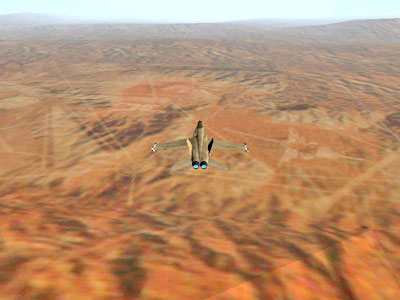
These lines appear over an area that covers 500 square
kilometers
and come in various forms and shapes; apart from lines, there are
also depictions of animals, including an ape, a whale, a snake, a
lama, a human being, a flower, etc. But the most prominent features
are the lines, etched here over a period of one millennium, from 500
BC to 500 AD.
The complex and the designs are so vast that little can be seen from
ground level. Small portions are visible, but the entire scope of
the “Nazca lines” is only visible from the air. The logical question
is therefore why this complex was constructed when it was invisible
– and the people who created it had not yet discovered flight. It
was this quagmire that von Däniken turned upside down, suggesting
those who constructed the complex did know the secret of flight. He
also underlined the straightness of the lines: over a distance of
1500 meters, the lines never deviate more than 4 meters. From this,
he observed that the complex looked similar to the design of modern
airports – could the Nazca lines be an airport for the
extraterrestrial deities?
Rather than answer the question with a stern “no”, scientists
preferred to laugh at the mere suggestion. In their favor, they
were aware that the ground itself was very uneven and rough, which
would mean that any plane trying to land there, would immediately
have a severe accident during landing. Though it looked like an
airport, an airport it was not.
The local tourist industry had other priorities: owners of local
airplanes were soon joined by many others who offered tourists the
possibility to make an “aborted landing” on the lines (i.e. the
pilots prepare for a landing as if the lines are the airport and
just before the landing, the plane pulls up again).
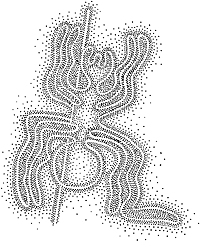 Though
von Däniken had thus
popularized the lines, they were not
unknown before his arrival. Maria Reiche was a German mathematician,
with an interest in the lines since shortly after World War II;
since the 1950s, she had lived near the lines, in an effort to
understand what they meant. For many years, she tried to bring the
lines to the attention of the scientific community. Though she would
largely fail, where von Däniken would succeed, in retrospect, both
are now considered to be pivotal in the public awareness of the
lines. Though
von Däniken had thus
popularized the lines, they were not
unknown before his arrival. Maria Reiche was a German mathematician,
with an interest in the lines since shortly after World War II;
since the 1950s, she had lived near the lines, in an effort to
understand what they meant. For many years, she tried to bring the
lines to the attention of the scientific community. Though she would
largely fail, where von Däniken would succeed, in retrospect, both
are now considered to be pivotal in the public awareness of the
lines.
Reiche believed that the lines had an astronomical function. The
lines were there to determine the position of the stars.
Unfortunately, a subsequent scientific analysis of her theory proved
it incorrect; though some lines were indeed marking astronomical
features, this correspondence was nothing out of the normal odds:
there are a large number of stars and a large number of lines, and
hence some should be aligned to some stars – by accident. Until her
death in 1998, Reiche nevertheless continued to defend her theory as
best as she could. But her biggest pre-occupation was the
conservation of the lines. She knew that every touch to the ground,
even a normal stroll through the area, left marks in the surface
that remained visible for many years afterwards.
Reiche was
therefore appalled to find that the lines had become a tourist
destination – in sharp contrast with the local people who looked
towards the tourists a new source of desperately needed income. The
“aborted landings” of the pilots made her shiver, fearing one day, a
plane would crash and destroy some of the lines. For most of her
life, she also found that the local authorities were not interested
in the lines and throughout her life, she fought to make the lines a
listed national monument. In the end, her struggle proved
successful.
But her theory as to what the lines were was incorrect. And von Däniken’s theory of an airstrip was equally impossible. The problem
is simple: if a plane ever did land on the lines, somehow able to
land on the rough terrain, the sheer displacement of air would
result in the lines being “blown off”: the top soil would once again
cover the scraped off areas, and the white lines of the soil
underneath would disappear.
In 1995, von Däniken returned to the area and asked the pilot to
search for more designs, which so far had not received any proper
attention. Rather than try to prove his earlier speculation, he now
hoped to show the vastness and complexity of the designs, which
included geometric patterns which he, or anyone else, could explain.
Nevertheless, his idea that the lines should be viewed from the air
inspired Jim Woodman and Julian Knott. An aircraft was unlikely, but
perhaps a hot air balloon would do? Rock paintings near the lines
show a balloon. The ends of several straight lines show blackened
rocks, suggesting they had been fired – perhaps repeatedly. Perhaps
they were indeed sites of sacred fires, but perhaps they were also
sites where the hot air was created to fill the balloon in order to
get lift off? Woodman and
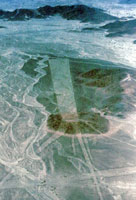 Knott built a primitive balloon, based on
the depictions on an ancient vase. They also used material that
would have been available to the local people. In 1975, “Condor I”
became airborne. The balloon flew for approximately 20 minutes and
covered a distance of 4.8 kilometers. It was practical proof that
the Nazca people could have used a balloon from which they would be
able to see the lines. But could never means they did… Knott built a primitive balloon, based on
the depictions on an ancient vase. They also used material that
would have been available to the local people. In 1975, “Condor I”
became airborne. The balloon flew for approximately 20 minutes and
covered a distance of 4.8 kilometers. It was practical proof that
the Nazca people could have used a balloon from which they would be
able to see the lines. But could never means they did…
Tony Morrison had made extensive expeditions in the region and knew
the theories of von Däniken, Reiche and many others. He soon
realized that most researchers were too focused on their own
research; all also paid too much attention on the lines, and not the
features that were on, along and near the lines. Morrison also spoke
to the local people, who had retained stories of how their distant
ancestors had constructed the lines. He learned that certain
sections of the network continued to be used by the local people for
religious purposes. Perhaps this could be the key to unlock the
mystery of the Nazca lines?
Morrison theorized that the network was a type of cemetery. The
desert area, where nothing could live, where no rain fell, was a
delineated area used by the local people to contact their ancestors.
This should not have come as a surprise, if we also know that the
local cultures were in origin shamanic.
Shamanic cultures use “shamans” (priests) to seek contact with the
gods, the ancestors, the dead. These are local in a different
dimension; they are not physical beings, but “spiritual entities”,
often the souls of the tribal ancestors, as well as creator deities.
The land of the dead was similar to Earth, but was found in another
dimension – here, yet invisible to our eyes. Morrison felt that the
clue to the Nazca lines was to be found here: the lines were an
ingenious system that aided the shaman in his “voyage of the soul”.
He argued that the lines often converged in certain nodes, from
which they continued. On these nodes and at regular intervals along
the lines, small altars could be found, sometimes little more than a
small heap of stones and earth.
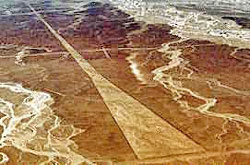 Morrison, and later
Paul Devereux, remarked that the most important
aspect of the lines had not been sufficiently focused upon. The
lines were straight. Straight lines were specifically linked with
the voyage of the shaman in the Otherworld, as well as with the
Otherworld in general. Souls were said to be only able to travel in
straight lines. “Dead roads”, “dead straight roads”, often linked
the church with the cemetery – if some distance separated them. Morrison, and later
Paul Devereux, remarked that the most important
aspect of the lines had not been sufficiently focused upon. The
lines were straight. Straight lines were specifically linked with
the voyage of the shaman in the Otherworld, as well as with the
Otherworld in general. Souls were said to be only able to travel in
straight lines. “Dead roads”, “dead straight roads”, often linked
the church with the cemetery – if some distance separated them.
Devereux has developed this concept and argues that it underpins the
concept of ley-lines: certain alignments in the landscape that form
straight lines. Devereux is very familiar with the concept of those
lines and argues that after many years of research in trying to
prove they were “energy lines”, he realized their true meaning,
particularly when he was confronted with a series of evidence from
Western Europe that showed that the concept of straight roads
survived in folklore. However, Devereux believed that as it was
shamanic in origin, it also went back to the earliest religious
notions of our ancestors – and thus would be a global phenomenon.
Though this seems to explain the straight lines, what to make of the
accompanying figures of animals and other forms and shapes? It is
believed that these animals predate the lines. Their size is often
massive, one figure measuring 275 meters. Remains of animal
sacrifice were sometimes found next to these animals.
Research into this area had been done by anthropologist Marlene Dobkin de Rios, who published a scientific thesis in 1977 on three
areas in the New World where she had found drug-using cultures that
had created designs onto the landscape. They were: the Hopewell
Indians of Northern America, the Olmecs of Mexico and the Nazca
culture of Peru.
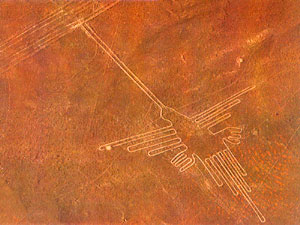 She argued that the animal depictions were magical protectors –
charms – for the shamans. They also acted as boundaries, so that
shamans of other tribes would not intervene in a certain territory.
Archaeologist Evan Haddingham continued this research and learnt
that similar practices continue to be observed by the local people
to this very day. She argued that the animal depictions were magical protectors –
charms – for the shamans. They also acted as boundaries, so that
shamans of other tribes would not intervene in a certain territory.
Archaeologist Evan Haddingham continued this research and learnt
that similar practices continue to be observed by the local people
to this very day.
Von Däniken was right when he suggested that the animals and lines
had to be seen from the sky. They were seen during the shamanic
flight, on his voyage to the Otherworld. Shamanic theory states that
the shaman leaves his body and “floats” or “soars” through the sky,
where often the eagle or another animal is his totem animal – the
animal mimics or symbolizes the flight of the soul. If these lines
were an airstrip, they were an airstrip for the soul – to take off
to and return from the Otherworld.
Morrison and other archaeologists/anthropologists are not concerned
whether or not the soul does indeed leave the body – or whether the
soul even exists. What is important is that the shamanic cultures
believed it existed, and lived accordingly – and built accordingly.
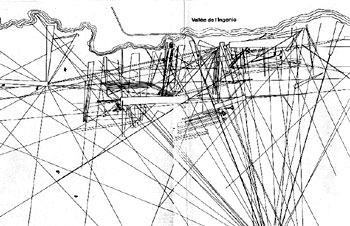 Dobkin de Rios agrees with this conclusion. She notes that the
design of the Nazca lines is also found on pottery and other objects
of the Nazca civilization; they often depicted the return of a god.
But rather than an extraterrestrial being, she argues that it is the
return of the shaman from his sacred duty, the soul voyage. Dobkin de Rios agrees with this conclusion. She notes that the
design of the Nazca lines is also found on pottery and other objects
of the Nazca civilization; they often depicted the return of a god.
But rather than an extraterrestrial being, she argues that it is the
return of the shaman from his sacred duty, the soul voyage.
She also
identified the cactus “San Pedro” (Trichocereus pachanoi) as the
plant that induced the shaman’s vision. The plant was also depicted
on various pots and even on ancient temples.
Modern tourists are not shown how to fly like a shaman – for that,
he needs to go to Iquitos, in the Amazon rain forest. But the
spectacular stunts of the local pilots along the lines and their
“aborted landings” probably comes quite close to the voyage of the
shaman. The shamans, however, did not require technology to see the
lines…
|


 Though
von Däniken had thus
popularized the lines, they were not
unknown before his arrival. Maria Reiche was a German mathematician,
with an interest in the lines since shortly after World War II;
since the 1950s, she had lived near the lines, in an effort to
understand what they meant. For many years, she tried to bring the
lines to the attention of the scientific community. Though she would
largely fail, where von Däniken would succeed, in retrospect, both
are now considered to be pivotal in the public awareness of the
lines.
Though
von Däniken had thus
popularized the lines, they were not
unknown before his arrival. Maria Reiche was a German mathematician,
with an interest in the lines since shortly after World War II;
since the 1950s, she had lived near the lines, in an effort to
understand what they meant. For many years, she tried to bring the
lines to the attention of the scientific community. Though she would
largely fail, where von Däniken would succeed, in retrospect, both
are now considered to be pivotal in the public awareness of the
lines.  Knott built a primitive balloon, based on
the depictions on an ancient vase. They also used material that
would have been available to the local people. In 1975, “Condor I”
became airborne. The balloon flew for approximately 20 minutes and
covered a distance of 4.8 kilometers. It was practical proof that
the Nazca people could have used a balloon from which they would be
able to see the lines. But could never means they did…
Knott built a primitive balloon, based on
the depictions on an ancient vase. They also used material that
would have been available to the local people. In 1975, “Condor I”
became airborne. The balloon flew for approximately 20 minutes and
covered a distance of 4.8 kilometers. It was practical proof that
the Nazca people could have used a balloon from which they would be
able to see the lines. But could never means they did… Morrison, and later
Paul Devereux, remarked that the most important
aspect of the lines had not been sufficiently focused upon. The
lines were straight. Straight lines were specifically linked with
the voyage of the shaman in the Otherworld, as well as with the
Otherworld in general. Souls were said to be only able to travel in
straight lines. “Dead roads”, “dead straight roads”, often linked
the church with the cemetery – if some distance separated them.
Morrison, and later
Paul Devereux, remarked that the most important
aspect of the lines had not been sufficiently focused upon. The
lines were straight. Straight lines were specifically linked with
the voyage of the shaman in the Otherworld, as well as with the
Otherworld in general. Souls were said to be only able to travel in
straight lines. “Dead roads”, “dead straight roads”, often linked
the church with the cemetery – if some distance separated them. She argued that the animal depictions were magical protectors –
charms – for the shamans. They also acted as boundaries, so that
shamans of other tribes would not intervene in a certain territory.
Archaeologist Evan Haddingham continued this research and learnt
that similar practices continue to be observed by the local people
to this very day.
She argued that the animal depictions were magical protectors –
charms – for the shamans. They also acted as boundaries, so that
shamans of other tribes would not intervene in a certain territory.
Archaeologist Evan Haddingham continued this research and learnt
that similar practices continue to be observed by the local people
to this very day. Dobkin de Rios agrees with this conclusion. She notes that the
design of the Nazca lines is also found on pottery and other objects
of the Nazca civilization; they often depicted the return of a god.
But rather than an extraterrestrial being, she argues that it is the
return of the shaman from his sacred duty, the soul voyage.
Dobkin de Rios agrees with this conclusion. She notes that the
design of the Nazca lines is also found on pottery and other objects
of the Nazca civilization; they often depicted the return of a god.
But rather than an extraterrestrial being, she argues that it is the
return of the shaman from his sacred duty, the soul voyage.